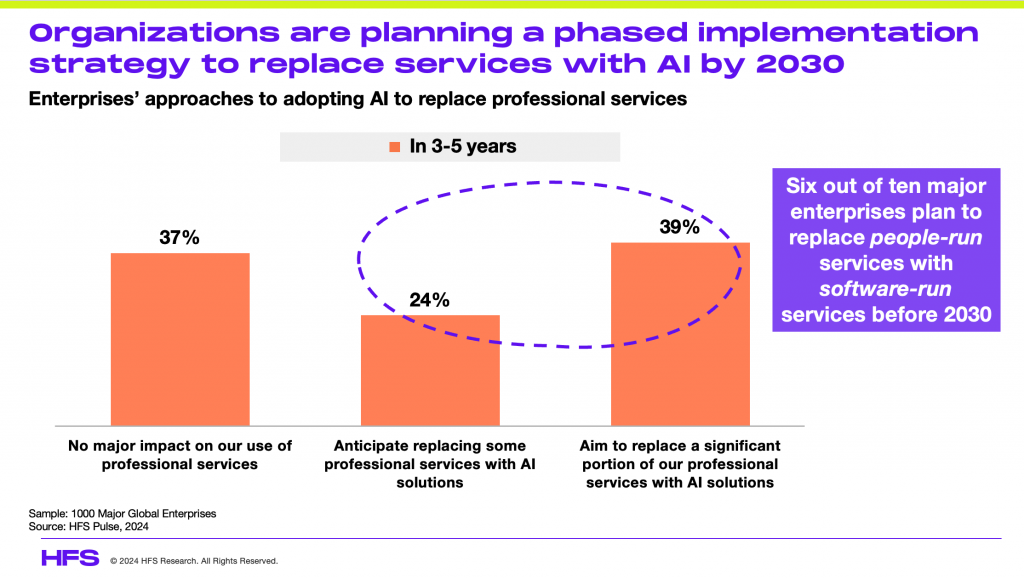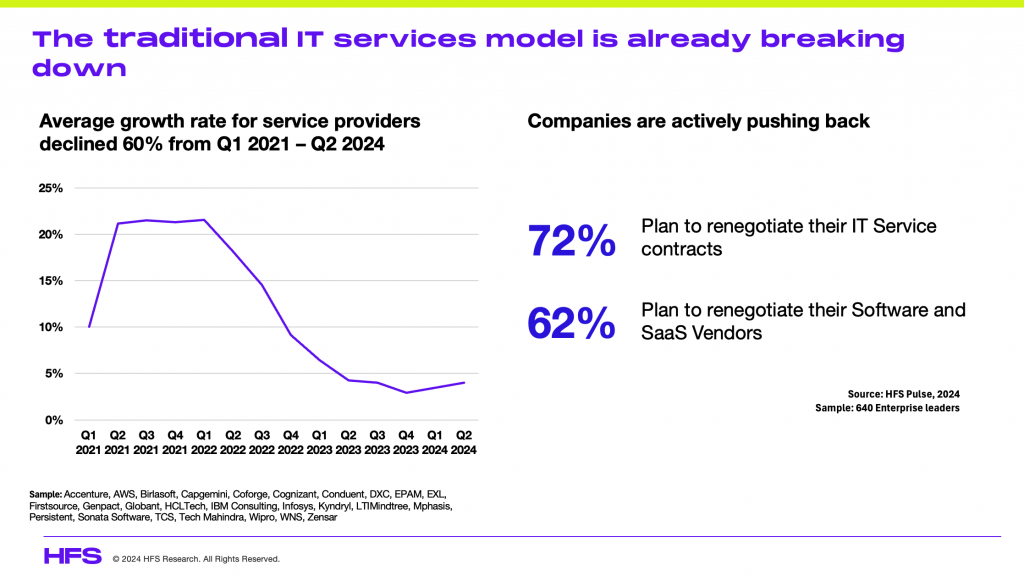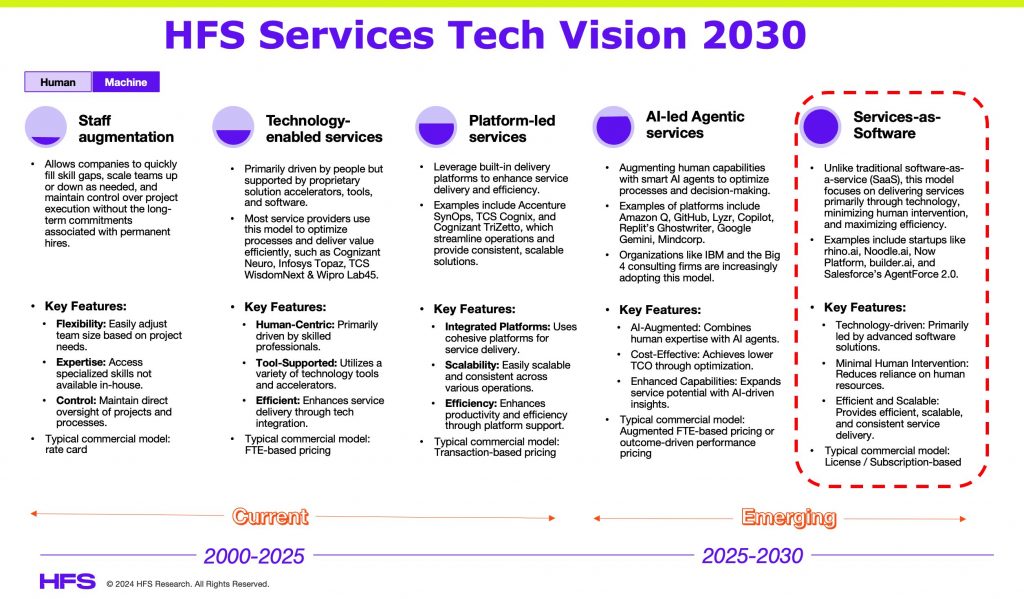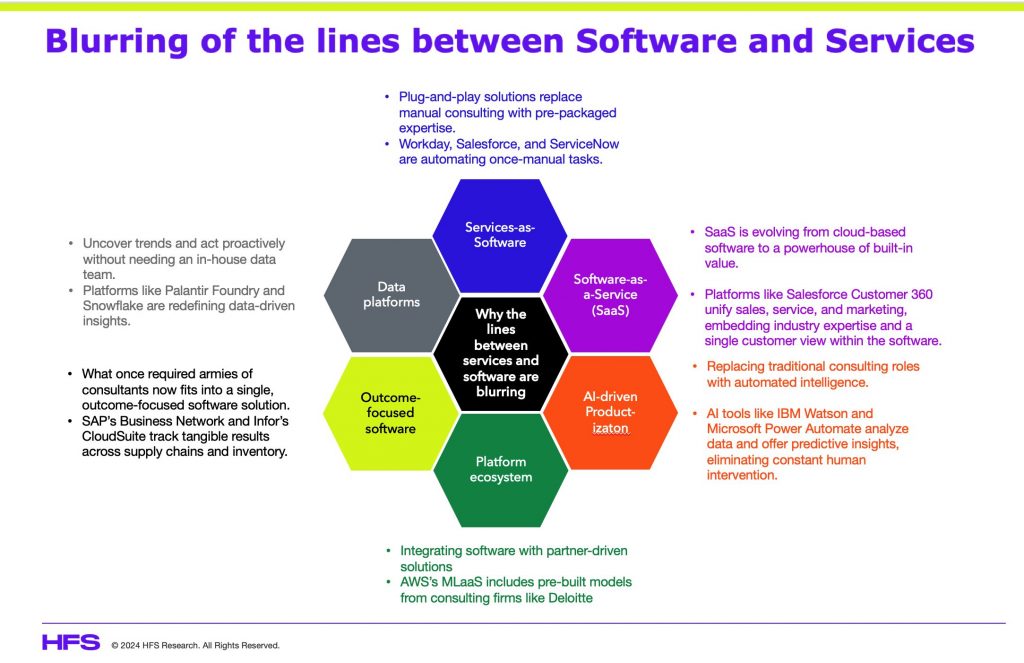Two very different worlds, one based on humans and the other on technology, are becoming one blended, scalable solution we are calling Services-as-Software. In short, the line between services and software is blurring and eventually vanishing, and this progression has become more crucial than ever.
Sixty percent of enterprises are already looking to procure services as technology offerings
A recent HFS study of 1000 major global enterprises reveals what is happening with stark brutality: Six out of ten enterprise leaders plan to replace some or all of their professional services with some form of AI within the next 3-5 years.

Services will continue to reduce their reliance on labor as automation creates more efficiency and productivity
The reality is that most people-based services, once they become predictable and routine, eventually become automated. This increasing sophistication of AI tools is enhancing the whole service efficiency and personalization experience. Once implemented effectively, these Services-as-Software solutions become faster to manage, cheaper to maintain, and more scalable to cope with volumes of demand.
For example, fully automated passport gates at airports now allow for higher volumes of passengers to clear immigration much quicker than previously and for more airlines to land their planes at the airport. This leads to more profitability for the airport, more business for the airlines and people to enter the country more expediently. Similarly, self-checkouts at grocery and convenience stores are enabling many more customers to have their purchases processed simultaneously, securely, and faster, which creates the ability to handle volume spikes without layering on unnecessary staffing costs to cater to demand.
Software-driven services can also improve the customer and employee experience
Now the airport can redeploy its people to manage issues at the passport gate when needed, to help shepherd them into the right lines, and also to provide assistance to elderly or disabled people. The whole experience is improved. Similarly, the convenience store can redeploy its staff to help customers find the products they need, to ensure inventory is better managed, to help manage in-store promotions, and to ensure the store is kept clean and presentable. Again, the customer and employee experience should be vastly improved, and the automation of the rote work allows more focus on improving the speed and quality of the whole business proposition.
While fairly simplistic, these are current real-world examples of how software embedded in enabled machines can not only replace the dependence on people to meet outcomes, but also enable organizations to scale their services without adding linear cost. The only differences with the emerging Services-as-Software model are the improvements in botifying routine white-collar work that was previously too challenging to automate due to limited technologies such as RPA and the absence of our ability to mimic and predict human behavior with the increasing sophistication of GenAI and Agentic software.
Services and software are equally exposed to full automation and AI
Enter the world of IT and business process services, and similar trends are in play as routine IT maintenance, HR, procurement, accounting, and customer service work are becoming much easier to replicate in advancing GenAI and Agentic software, supported by public and private cloud capabilities to secure and scale transaction volumes.
You only need to observe the rapid decline of growth in the labor-intensive services sector and the determination of enterprise customers to renegotiate both their services and software contracts to understand this dynamic is now in full swing:

Organizations face mounting pressure to deliver results faster, at scale, and with limited resources—all while managing increasingly complex technology ecosystems. The convergence of services and software meets that demand by transforming traditional consulting and outsourcing into scalable, automated solutions.
The 2030 destination is Services-as-Software, where the focus is on service provision performed by AI, not people
With the application of software platforms, Agentic solutions, and, ultimately, autonomous services mimicked by software, we believe we are on a fast track to reach an autonomous, human-lite nirvana of scalable, profitable, and affordable services by 2030:
These five phases of services tell the complete story of the industry’s evolution from adding people to perform work to scaling these same people with the smart use of platforms, AI-driven Agentic tools, and ultimately fully autonomous technology-led services where work is effectively replicated at scale with embedded intelligence.
In short, we are getting more of the same work without having to spend more on that same work. Instead, we can invest that money in value-added areas that cannot be mimicked by AI. Enterprises must adapt quickly to this shift as Agentic AI can autonomously handle complex decision-making tasks. This will impact both workforce roles and the enterprise software landscape, reducing the need for repetitive, decision-heavy positions and consolidating software functions under AI-driven platforms.
How the lines between services and software are blurring
This new model (see exhibit below) allows businesses to access continuous insights, predictive analytics, and outcome-driven solutions that adapt in real-time. It’s not just about streamlining operations; it’s about fueling growth and resilience, accelerating companies ahead in a world where speed and adaptability are critical to success. Let’s explore how this is already happening at speed:
- Services-as-Software (SaaS 2.0): Providers like Workday and ServiceNow are shifting from traditional consulting models to plug-and-play solutions that automate once-manual tasks. Workday’s People Analytics and ServiceNow’s ITSM are prime examples—what once required hours of consulting is now pre-packaged expertise delivering instant results.
- SaaS as the New Backbone: SaaS is evolving from cloud-based software to a powerhouse of built-in value. Platforms like Salesforce’s Customer 360 bundle sales, service, and marketing insights into one, reducing the need for external CRM optimization by embedding industry-specific expertise and a single customer view across the lifecycle right within the software.
- AI-Driven Productization: AI tools like IBM Watson and Microsoft Power Automate are replacing traditional consulting roles with automated intelligence. IBM Watson isn’t just a chatbot but a full-scale AI ecosystem that analyzes data and offers predictive insights, eliminating constant human intervention.
- Platform Playgrounds: Ecosystems like AWS and Google Cloud go beyond tech infrastructure by integrating software and partner-driven solutions. AWS’s MLaaS, for instance, includes pre-built models from consulting firms like Deloitte, allowing its enterprise clients to tap into sophisticated AI solutions without custom builds. KPMG has invested significantly in the GenAI platform Rhino.ai to modernize legacy applications, while, and IBM has been developing out its watsonx platforms to replicate many routine business services in a one-to-many scalable delivery model.
- Outcome Obsession: Companies like SAP and Infor focus on outcome-driven solutions, with SAP’s Business Network and Infor’s CloudSuite tracking tangible results across supply chains and inventory. What once required armies of consultants now fits into a single, outcome-focused software solution.
- Data as a Weapon: Platforms like Palantir Foundry and Snowflake are redefining data-driven insights. Palantir Foundry continuously analyzes business data for actionable intelligence, while Snowflake’s Data Cloud empowers companies to uncover trends and act proactively without needing an in-house data team.
The Bottom-line: In this new service-as-software era, the distinction between service and software is practically erasing.
Businesses now access pre-built solutions, automated workflows, and data-powered insights, creating a seamless and scalable experience that puts the power of technology and expertise directly at their fingertips. Services firms will increasingly look to their software partners and investments to streamline and provide greater value to entrprise clients, as this GenAI ecosystem unfolds. This model doesn’t just support business goals—it accelerates them, transforming how companies achieve impact in a world where speed and adaptability are the ultimate competitive advantage.
The challenge we all face – whether we buy, sell, advise or analyze this merging of markets is changing how we articulate, commercialize and deliver outcomes. Services and software people come from different worlds and speak different languages, but now these need to come together in a way we can all understand and develop. We can’t simply buy shiny new S-a-S solutions and plug them in like we did with an ERP solution. This is where we need to define real business value, which can be delivered by AI technology and price according to that value and the desired outcomes we expect. There is a huge opportunity for service providers to guide their clients to a state where they are ready for S-a-S solutions. There is also the potential for services and software firms to merge together as this new market emerges – there are already multiple discussions and partnerships taking place that are readying for 2025 and beyond.
Welcome to the era of uncertain change, everyone… where uncertainty will breed opportunity!
Posted in : Agentic AI, Artificial Intelligence, Automation, Cloud, Consulting, GenAI, Generative Enterprise, OneEcosystem, OneOffice, SaaS, PaaS, IaaS and BPaaS, Services-as-Software








